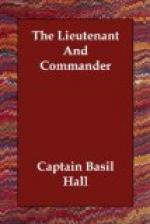Calms, also, are met with in this intermediate region, or purgatory of the outward-bound voyage, and occasionally violent tornados or squalls, which in a moment tear away every rag of canvas from a ship’s yards. For several hours at a time, also, rain falls down in absolute torrents. Even when the weather clears up, and a fresh breeze comes, it is generally from the southward, directly in the outward-bound navigator’s teeth. He must have patience, however, and strive to make the most of it by keeping on that tack by which most southing is to be gained. It is now, I believe, generally held to be the best practice to place the ship between 18 deg. and 23 deg. of west longitude on losing the north-east Trade; and likewise to endeavour, if possible, to cross the equator somewhere between these two longitudes. Before reaching the line, however, the navigator will almost always be met by the south-east Trade-wind. From January to May he may expect to meet it in 1 deg. or 2 deg. north latitude; but in summer and autumn he will find the northern or equatorial limit of the south-east Trade a degree or two still further to the northwards of the lines.
On first encountering the south-east Trade an outward-bound ship is obliged to steer much more to the westward than she wishes to do, in consequence of the wind blowing so directly towards the equator, and not along it, as some of the books will insist on, in spite of Nature. So that if she be a dull sailer she may have some difficulty in weathering the coast of Brazil about Cape St. Roque. As she proceeds onwards, however, and makes a little more southing, the wind will haul more and more round from the south to the south-east, then east-south-east, and eventually to east at the southern limit of the Trade-wind. An inexperienced sailor, on first entering the south-east Trade, is very apt to be too solicitous about making southing, and hugs the wind much too close; whereas he ought rather to keep his ship off a little, give her a fathom or two of the fore and main sheets, and take a small pull of the weather topsail and top-gallant braces, to ensure making good way through the water. Indeed, many officers go so far as to recommend flanking across the south-east Trade with a fore-topmast studding-sail set. Although, I think, there can be no doubt of the soundness of this advice, I confess that it does require no inconsiderable degree of faith to adopt a course, which, apparently, takes the ship not directly away from her object, but very much out of the straight road. In this respect, it may be remarked that the scale of navigation on every Indian voyage is so great, and the importance of getting into those parallels where favourable breezes are certain to be met with, of so much more consequence than the gain of mere distance, that two or three hundred miles to the right or left, or even twice that space, is often not to be regarded. Accordingly, in cutting or flanking across the south-east Trade-wind, the object, it should be remembered, is not to shorten the distance, but to reach those latitudes where strong westerly gales are to be met with, by help of which five hundred or a thousand miles of lost distance are speedily made up, and the rest of the passage secured.




